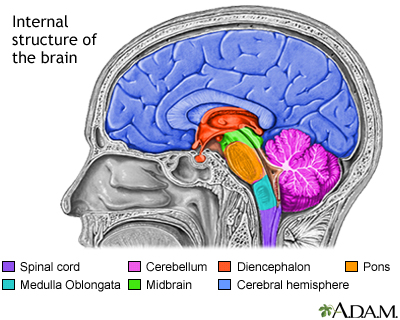Progressive supranuclear palsy
Dementia - nuchal dystonia; Richardson-Steele-Olszewski syndrome; Palsy - progressive supranuclear
Progressive supranuclear palsy (PSP) is a movement disorder that occurs from damage to certain nerve cells in the brain.
Images

I Would Like to Learn About:
Causes
PSP is a condition that causes symptoms similar to those of Parkinson disease.
It involves damage to many cells of the brain. Many areas are affected, including the part of the brainstem where cells that control eye movement are located. The area of the brain that controls steadiness when you walk is also affected. The frontal lobes of the brain are also affected, leading to personality changes.
The cause of the damage to the brain cells is unknown. PSP gets worse over time.
People with PSP have deposits in brain tissues that look like those found in people with Alzheimer disease. There is a loss of tissue in most areas of the brain and in some parts of the spinal cord.
The disorder is most often seen in people over 60 years old, and is somewhat more common in men.
Symptoms
Symptoms may include any of the following:
- Loss of balance, repeated falls
- Lunging forward when moving, or fast walking
- Bumping into objects or people
- Changes in expressions of the face
- Deeply lined face
- Eye and vision problems such as different sized pupils, difficulty moving the eyes (supranuclear ophthalmoplegia), lack of control over the eyes, problems keeping the eyes open
- Difficulty swallowing
- Tremors, jaw or face jerks or spasms
- Mild-to-moderate dementia
- Personality changes
- Slow or stiff movements
- Speech difficulties, such as low voice volume, not able to say words clearly, slow speech
- Stiffness and rigid movement in the neck, middle of the body, arms, and legs
Exams and Tests
An exam of the nervous system (neurologic exam) may show:
- Dementia that is getting worse
- Difficulty walking
- Limited eye movements, especially up and down movements
- Inability to keep eyes open
- Normal vision, hearing, feeling, and control of movement
- Stiff and uncoordinated movements like those of Parkinson disease
Your health care provider may do the following tests to rule out other diseases:
- MRI might show shrinking of the brainstem (hummingbird sign)
- PET scan of the brain will show changes in the front of the brain
Treatment
The goal of treatment is to control symptoms. There is no known cure for PSP.
Medicines such as levodopa (combined with carbidopa) may be tried. These medicines raise the level of a brain chemical called dopamine. Dopamine is involved in the control of movement. The medicines may reduce some symptoms, such as rigid limbs or slow movements for a time. But they are usually not as effective as they are for Parkinson disease.
Many people with PSP will eventually need around-the-clock care and monitoring as they lose brain functions.
Outlook (Prognosis)
Treatment sometimes can reduce symptoms for a while, but the condition will get worse. Brain function will decline over time. Death commonly occurs in 5 to 7 years.
Newer medicines are being studied to treat this condition.
Possible Complications
Complications of PSP include:
- Blood clot in veins (deep vein thrombosis) due to limited movement
- Injury from falling
- Lack of control over vision
- Loss of brain functions over time
- Pneumonia due to trouble swallowing
- Poor nutrition (malnutrition)
- Side effects from medicines
When to Contact a Medical Professional
Contact your provider if you often fall, and if you have a stiff neck/body, and vision problems.
Also, call if a loved one has been diagnosed with PSP and the condition has declined so much that you can no longer care for the person at home.
Related Information
Parkinson diseaseDementia
Alzheimer disease
Myelin
Deep vein thrombosis
Community-acquired pneumonia in adults
References
Jankovic J. Parkinson disease and other movement disorders. In: Jankovic J, Mazziotta JC, Pomeroy SL, Newman NJ, eds. Bradley and Daroff's Neurology in Clinical Practice. 8th ed. Philadelphia, PA: Elsevier;2022:chap 96.
National Institute of Neurological Disorders and Stroke website. Progressive supranuclear palsy (PSP). www.ninds.nih.gov/health-information/disorders/progressive-supranuclear-palsy-psp. Updated November 28, 2023. Accessed June 28, 2024.
Rowe JB, Holland N, Rittman T. Progressive supranuclear palsy: diagnosis and management. Pract Neurol. 2021;21(5):376-383. PMID: 34215700 pubmed.ncbi.nlm.nih.gov/34215700/.
BACK TO TOPReview Date: 6/13/2024
Reviewed By: Joseph V. Campellone, MD, Department of Neurology, Cooper Medical School at Rowan University, Camden, NJ. Review provided by VeriMed Healthcare Network. Also reviewed by David C. Dugdale, MD, Medical Director, Brenda Conaway, Editorial Director, and the A.D.A.M. Editorial team.

Health Content Provider
06/01/2025
|
A.D.A.M., Inc. is accredited by URAC, for Health Content Provider (www.urac.org). URAC's accreditation program is an independent audit to verify that A.D.A.M. follows rigorous standards of quality and accountability. A.D.A.M. is among the first to achieve this important distinction for online health information and services. Learn more about A.D.A.M.'s editorial policy, editorial process and privacy policy. A.D.A.M. is also a founding member of Hi-Ethics. This site complied with the HONcode standard for trustworthy health information from 1995 to 2022, after which HON (Health On the Net, a not-for-profit organization that promoted transparent and reliable health information online) was discontinued. |
The information provided herein should not be used during any medical emergency or for the diagnosis or treatment of any medical condition. A licensed medical professional should be consulted for diagnosis and treatment of any and all medical conditions. Links to other sites are provided for information only -- they do not constitute endorsements of those other sites. © 1997- 2025 A.D.A.M., a business unit of Ebix, Inc. Any duplication or distribution of the information contained herein is strictly prohibited.
